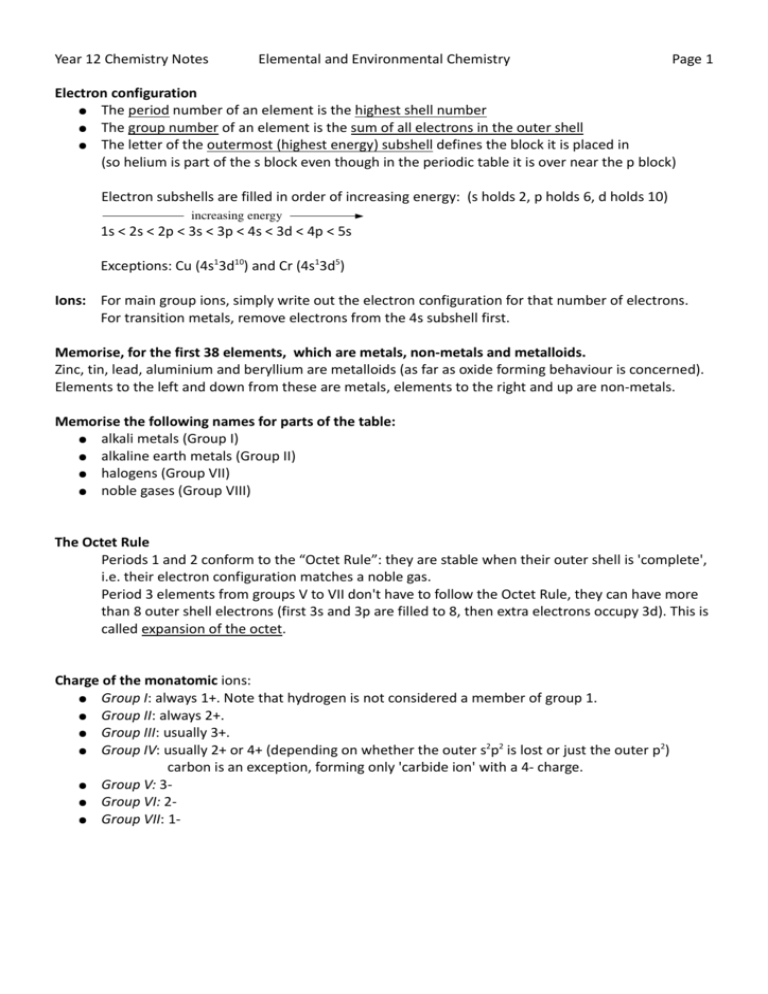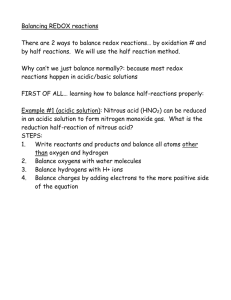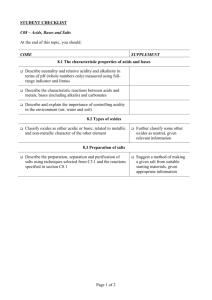Year 12 Chemistry Notes Elemental and Environmental Chemistry
advertisement

Year 12 Chemistry Notes Elemental and Environmental Chemistry Page 1 Electron configuration ● The period number of an element is the highest shell number ● The group number of an element is the sum of all electrons in the outer shell ● The letter of the outermost (highest energy) subshell defines the block it is placed in (so helium is part of the s block even though in the periodic table it is over near the p block) Electron subshells are filled in order of increasing energy: (s holds 2, p holds 6, d holds 10) increasing energy 1s < 2s < 2p < 3s < 3p < 4s < 3d < 4p < 5s Exceptions: Cu (4s13d10) and Cr (4s13d5) Ions: For main group ions, simply write out the electron configuration for that number of electrons. For transition metals, remove electrons from the 4s subshell first. Memorise, for the first 38 elements, which are metals, non-metals and metalloids. Zinc, tin, lead, aluminium and beryllium are metalloids (as far as oxide forming behaviour is concerned). Elements to the left and down from these are metals, elements to the right and up are non-metals. Memorise the following names for parts of the table: ● alkali metals (Group I) ● alkaline earth metals (Group II) ● halogens (Group VII) ● noble gases (Group VIII) The Octet Rule Periods 1 and 2 conform to the “Octet Rule”: they are stable when their outer shell is 'complete', i.e. their electron configuration matches a noble gas. Period 3 elements from groups V to VII don't have to follow the Octet Rule, they can have more than 8 outer shell electrons (first 3s and 3p are filled to 8, then extra electrons occupy 3d). This is called expansion of the octet. Charge of the monatomic ions: ● Group I: always 1+. Note that hydrogen is not considered a member of group 1. ● Group II: always 2+. ● Group III: usually 3+. 2 2 2 ● Group IV: usually 2+ or 4+ (depending on whether the outer s p is lost or just the outer p ) carbon is an exception, forming only 'carbide ion' with a 4- charge. ● Group V: 3● Group VI: 2● Group VII: 1- Year 12 Chemistry Notes Elemental and Environmental Chemistry Page 2 Electronegativities (arrow indicates increasing electronegativity) Metals: low electronegativity Metalloids: intermediate electronegativity Non-metals: high electronegativity Oxidation number (oxidation state) rules, in order: ● All elemental state atoms are zero ● Hydrogen is usually +1 (in compounds) except as a metal hydride, where it is -1 ● Oxygen is usually -2 (in compounds) except in hydrogen peroxide (H2O2) where it is -1 ● Monatomic ions have oxidation number equal to their charge ● The sum of the oxidation numbers in a compound equals zero ● The sum of the oxidation numbers in a polyatomic ion equals the charge on the ion Note: Oxidation numbers are always written sign then number (e.g. +1), whereas charges are written number then sign (e.g. 1+). Covalent bonding A covalent bond is formed by the sharing of valence electrons between two atoms. The shared electrons orbit both atoms and are considered in each atom's valence shell. By this sharing or electrons atoms can each increase the number of electrons they have and become more stable. Covalence is the number of electrons shared during covalent bonding to make the atom stable. Notice the relationship between the likely covalences and the number of electrons in the subshells. ● ● ● ● ● ● ● Group I: does not form covalent bonds Group II: does not form covalent bonds Group III: 3 (boron only) Group IV: 2 or 4 (except the metals) Group V: 3 or 5 (depending on whether the outer s2p3 is shared or just the outer p3) Group VI: 2, 4 or 6 (two of the outer p4, all the outer p4, or all of the outer s2p4) Note: oxygen never exhibits covalence of 4 or 6 Group VII: 1, 3, 5 or 7 (one, three or all of the p5, or all seven of the s2p5) Note: fluorine never exhibits covalence of 3,5 or 7 The magnitudes of the likely oxidation states are equal to the covalences. Year 12 Chemistry Notes Elemental and Environmental Chemistry Page 3 Acidic, Basic and Amphoteric Oxides Oxides (compounds of an element with oxygen) can be classified as acidic, basic or amphoteric: ● Acidic ○ React with hydroxide ions to produce oxyanions (negatively charged ions consisting of the element and oxygen) and water. ○ React with water (if soluble in water) to form oxyacids (acids consisting of the element, hydrogen and oxygen). ○ Oxides of non-metals are acidic. ● Basic ○ React with acids (or hydrogen ions) to produce positively charged metal ions and water molecules. ○ React with water (if soluble in water) to form metal ions and hydroxide ions. ○ Oxides of metals are basic. ● Amphoteric (can behave either as acidic or basic) React with hydroxide ions to produce oxyanions (negatively charged ions consisting of the element and oxygen) and water. ○ React with acids (or hydrogen ions) to produce positively charged metal ions and water molecules. ○ Do not react with water. ○ Oxides of metalloids (zinc, tin, lead, aluminium and beryllium) are amphoteric. ○ Memorise the acidic oxides below (and their corresponding oxyanions) Any other oxides required can be determined simply from standard formula balancing. The left is the oxide, the right is the oxyanion formed by that particular oxide. C CO32- CO CO2 NO NO2 Si SiO2 23 SiO P4O10 N O NO2- + NO3- - P S PO4 3- SO2 SO3 SO32SO42- Note: Silicon oxide is not soluble in water (even though it is an acidic oxide) To write metallic and basic oxides: balance the formula according to standard oxidation number rules. To construct the oxyanion formed by an amphoteric oxide: attach just enough oxides to a single metal atom to give the molecule a negative charge. The oxidation state of the metal or metalloid is maintained. You may notice that most of the oxyanions of acidic oxides could be constructed this way too.






